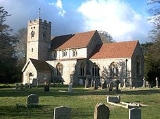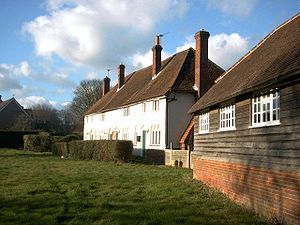
Great Hampden
Encyclopedia
Great and Little Hampden is a civil parish in Buckinghamshire
, England
, about three miles south-east of Princes Risborough
. It incorporates the villages of Great Hampden and Little Hampden, and the hamlets
of Green Hailey and Hampden Row. Great Hampden is the ancestral home of the Hobart-Hampden family, the most famous of whom was the English Civil War
hero John Hampden
.
of 1086, when they were jointly called Hamdena after the owners of the local manor.
By the 14th century 'Hamdena' was split into the two villages, Great Hampden at the top of one hill and Little Hampden on the next hill, with the lush arable land
forming the rest of the two parishes spread out in the valley between them. It was also at about this time that Hampden House
, the house belonging to the Hobart-Hampden family was rebuilt.
After the death of John Hampden, a cross was erected just above the lane that leads from Hampden House to the nearby village of Prestwood
. Where the cross stands is reputed to be the spot where John Hampden stood when he first refused to pay the Ship Money
tax in 1636. However the nearby village of Great Kimble also claims to be the place where he refused to pay the tax. From the cross there is a view of the Chiltern Hills
.
 Hampden himself is buried at the church in Great Hampden, in an unmarked grave. His first wife had a stone tablet in her honour erected in the chancel
Hampden himself is buried at the church in Great Hampden, in an unmarked grave. His first wife had a stone tablet in her honour erected in the chancel
. In the 19th century the floor below this tablet was lifted and a body exhumed which was missing its hand and had had its shoulder dislocated. Due to the nature of Hampden's death at the Battle of Chalgrove Field
near Thame
(he died as a result of an injury to his arm and shoulder) this was assumed to be the body of Hampden himself, however this assumption has since been challenged by other historians.
Great Hampden church stands a mile or so from the village. Its isolation made it an attractive location for some scenes in the 1970 film Cromwell
. In more modern times Hampden House was used extensively by the Hammer film studios as the perfect gothic backdrop for many of their films.
The nave of Little Hampden Church was built in the 13th Century and a distinctive half timbered porch was added in the 15th century. There are 13th century wall paintings of saints inside that were discovered in 1907, however they are incomplete due to a major rebuild of the chancel in 1859. Opposite the church is Manor Farm which is white plastered.
Buckinghamshire
Buckinghamshire is a ceremonial and non-metropolitan home county in South East England. The county town is Aylesbury, the largest town in the ceremonial county is Milton Keynes and largest town in the non-metropolitan county is High Wycombe....
, England
England
England is a country that is part of the United Kingdom. It shares land borders with Scotland to the north and Wales to the west; the Irish Sea is to the north west, the Celtic Sea to the south west, with the North Sea to the east and the English Channel to the south separating it from continental...
, about three miles south-east of Princes Risborough
Princes Risborough
Princes Risborough is a small town in Buckinghamshire, England, about 9 miles south of Aylesbury and 8 miles north west of High Wycombe. Bledlow lies to the west and Monks Risborough to the east. It lies at the foot of the Chiltern Hills, at the north end of a gap or pass through the Chilterns,...
. It incorporates the villages of Great Hampden and Little Hampden, and the hamlets
Hamlet (place)
A hamlet is usually a rural settlement which is too small to be considered a village, though sometimes the word is used for a different sort of community. Historically, when a hamlet became large enough to justify building a church, it was then classified as a village...
of Green Hailey and Hampden Row. Great Hampden is the ancestral home of the Hobart-Hampden family, the most famous of whom was the English Civil War
English Civil War
The English Civil War was a series of armed conflicts and political machinations between Parliamentarians and Royalists...
hero John Hampden
John Hampden
John Hampden was an English politician, the eldest son of William Hampden, of Hampden House, Great Hampden in Buckinghamshire, John Hampden (ca. 15951643) was an English politician, the eldest son of William Hampden, of Hampden House, Great Hampden in Buckinghamshire, John Hampden (ca. 15951643)...
.
History
The villages were first mentioned in the Domesday BookDomesday Book
Domesday Book , now held at The National Archives, Kew, Richmond upon Thames in South West London, is the record of the great survey of much of England and parts of Wales completed in 1086...
of 1086, when they were jointly called Hamdena after the owners of the local manor.
By the 14th century 'Hamdena' was split into the two villages, Great Hampden at the top of one hill and Little Hampden on the next hill, with the lush arable land
Arable land
In geography and agriculture, arable land is land that can be used for growing crops. It includes all land under temporary crops , temporary meadows for mowing or pasture, land under market and kitchen gardens and land temporarily fallow...
forming the rest of the two parishes spread out in the valley between them. It was also at about this time that Hampden House
Hampden House
Hampden House is a country house in the village of Great Hampden, between Great Missenden and Princes Risborough in Buckinghamshire. It is named after the Hampden family. The Hampdens are recorded as owning the site from before the Norman conquest...
, the house belonging to the Hobart-Hampden family was rebuilt.
After the death of John Hampden, a cross was erected just above the lane that leads from Hampden House to the nearby village of Prestwood
Prestwood
Prestwood is a village in Buckinghamshire, England. It is located in the Chiltern Hills, about a mile west of Great Missenden, four miles north of High Wycombe.-Early history and creation of parish:...
. Where the cross stands is reputed to be the spot where John Hampden stood when he first refused to pay the Ship Money
Ship money
Ship money refers to a tax that Charles I of England tried to levy without the consent of Parliament. This tax, which was only applied to coastal towns during a time of war, was intended to offset the cost of defending that part of the coast, and could be paid in actual ships or the equivalent value...
tax in 1636. However the nearby village of Great Kimble also claims to be the place where he refused to pay the tax. From the cross there is a view of the Chiltern Hills
Chiltern Hills
The Chiltern Hills form a chalk escarpment in South East England. They are known locally as "the Chilterns". A large portion of the hills was designated officially as an Area of Outstanding Natural Beauty in 1965.-Location:...
.

Chancel
In church architecture, the chancel is the space around the altar in the sanctuary at the liturgical east end of a traditional Christian church building...
. In the 19th century the floor below this tablet was lifted and a body exhumed which was missing its hand and had had its shoulder dislocated. Due to the nature of Hampden's death at the Battle of Chalgrove Field
Battle of Chalgrove Field
The Battle of Chalgrove was a small battle during the English Civil War in the county of Oxfordshire. It took place around 09:00 hours on the morning of 18 June 1643 in Chalgrove Field, northeast of Chalgrove in Oxfordshire...
near Thame
Thame
Thame is a town and civil parish in Oxfordshire, about southwest of the Buckinghamshire town of Aylesbury. It derives its toponym from the River Thame which flows past the north side of the town....
(he died as a result of an injury to his arm and shoulder) this was assumed to be the body of Hampden himself, however this assumption has since been challenged by other historians.
Great Hampden church stands a mile or so from the village. Its isolation made it an attractive location for some scenes in the 1970 film Cromwell
Cromwell (film)
Cromwell is a 1970 film, based on the life of Oliver Cromwell who led the Parliamentary forces during the English Civil War and, as Lord Protector, ruled Great Britain and Ireland in the 1650s. It features an all-star cast led by Richard Harris as Cromwell and Alec Guinness as King Charles I...
. In more modern times Hampden House was used extensively by the Hammer film studios as the perfect gothic backdrop for many of their films.
The nave of Little Hampden Church was built in the 13th Century and a distinctive half timbered porch was added in the 15th century. There are 13th century wall paintings of saints inside that were discovered in 1907, however they are incomplete due to a major rebuild of the chancel in 1859. Opposite the church is Manor Farm which is white plastered.

